Hey,
Here are some pics of my homemade outdoor wood stove.
The stove’s made up of two large pipes, one 48″ dia. by 10′ long (the water jacket/tank) and the other 36″ dia. by 51″ long (the firebox). The firebox (firecylinder?) sits inside the larger tank, sticking out the front end by a few inches, offcenter toward the bottom. The smoke and exhaust leaves the firebox via two 8″ pipes out its back wall and goes the length of the larger tank and out the end into a cleanout box. From this rear cleanout box, three 6″ pipes go all the way back through the tank and into a front cleanout box, from which the smoke goes up the stack (single wall black stove pipe). The front door and rear cleanout box door are both water jacketed, with internal baffles.
It’s made completely out of mild steel, all 1/4″ thick except for the firebox and front door, which is 3/8″. The front door hinges on a piece of solid rod that swings on a couple pillow block bearings. This door is adjustable in all three axis as needed. The door handle is gen-u-wine elk horn. The latches for the clean-out doors are made from some cheap bar clamps I bought.
I guesstimate that the stove holds maybe 500 gallons of water. I use straight water, no antifreeze.
I have several water line connections in the back of the stove. One goes to the house; the return from this is dumped into the top of the stove, near the back. This line has a Taco 009 pump on it. Another pump, a Taco 007, does nothing but circulate the water in the tank, pulling off the rear bottom and dumping it right on top of the firebox. Without this second pump, it boils and overheats very easily.
I made the insulated 150′ lines to the house out of 1″ PEX, foil-faced foam insulation, and a single length of solid drain tile. It’s buried 2′ deep. I have temp gauges on both ends; the water loses 4 degrees over that length. The water lines to the doors are 1″ heater hose from the car parts store.
I currently have a solenoid on the damper door in the front connected to an aquastat (I put this on after the pics were taken). When the water reaches 180, the damper closes. When the temp falls to 170, it opens again. It pretty much stays in that range all the time. I don’t have a draft fan and I burn dry oak. Last night I filled the firebox and tonight I still had wood in there, probably could’ve made it until tomorrow morning, although I threw some more in anyway. On cold days, I add wood once in the morning and once in the evening. I hope to cut this back to once a day all the time, even cold days, when I get the shed insulated and a proper door put on.
I didn’t insulate the stove itself. I built the shed around it and my plan is to insulate that. That way, considering that I’ll probably need to tinker with it over time, this’ll make it easier to service. Don’t have the insulation or the wiring done in the shed. Nor do I have the outside trim or door done. I’m sure I’m losing a ton of heat to atmosphere; for now, that’s OK.
I’d probably make a few tweaks to the design if I made one again, but overall I’m very pleased with how it works. The firetubes capture lots of heat, probably at least as much as the firebox itself. This makes it efficient in terms of how much heat is captured and put into the water. On the other hand, it causes the stack to run very cool, which generates lots of creosote, so I have to stay on top of cleaning the stack and firetubes. The other thing I’m considering is putting a draft inducer fan in the stack–not to make it burn hotter, but to suck up the stack the majority of the smoke when I open the door. Without it, opening the door causes a lot of smoke to billow out the front.
Before I got it running, I was a little worried the 500 gallons would be hard to keep hot; that’s a lot of water. Having run it a month now, I can say that is definitely not a problem. I could have 500 gallons of boiling water in no time if I wanted to.
It currently heats only 1600 sq. feet; eventually, it’ll heat 3700 sq. feet of house, 1000 sq. feet of garage, and who-knows-how-big-future outbuilding. I figure I’ve probably got 3K in the stove, insulated lines and interior plumbing related to the stove, but not including the shed.
I got the basic idea for this design from a document called “Getting Into Hot Water; A Practical Guide For Hot Water Heating Systems” by some prof at some university in North Carolina. I’d say it works pretty good.
Brent
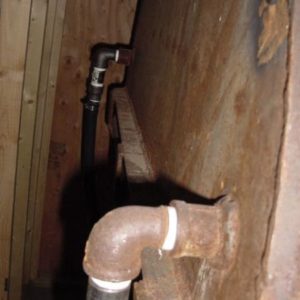
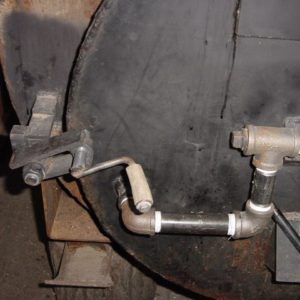
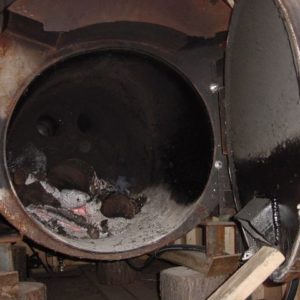
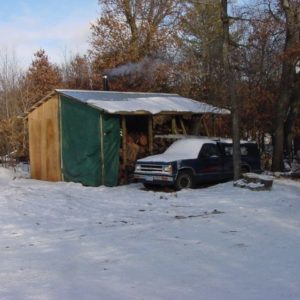
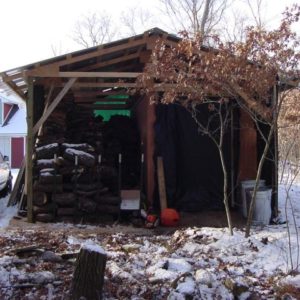
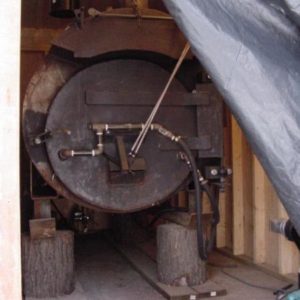



















Replies
Brent, That is awesome. Now I know how to get rid of my huge eucalyptus chunks that refuse to split in a hydraulic splitter. We have six acres overrun with eucalyptus.
How big a chunk can you put in yours?
How often do you shut it down to clean out ashes?
Does the low flue temp lead to a lot of particulate emissions? Any complaints from your wife/occupants of the house about ash/soot settling.
Were the steel cylinders salvaged? I picture using an old 150 gal propane tank for the firebox?
What all can you heat with the boiler??
Domestic hot water with a heat exchanger
Radiators or radiant floor heat
Hot water for the hot tub
There must be additonal uses?
I want to build one, how do I get design info?
Thanks for posting,
Karl
Edited 12/22/2005 10:41 pm ET by karl
Wood chunks can be up to 4' long and as big a diameter as I can lift. Since my wood source is primarily oak, I generally have to cut them shorter due to their sheer weight. The bigger the piece, the better, since they burn for a long time that way. While some of my wood is split, much of it is not.I clean the firebox out about once a week. I use a modified snow rake, the kind with the long handle normally used to pull snow off the roof, with the blade on the end trimmed into a radius shape to match the firebox radius.I've got the stack poking up above the building 3-4 feet, must be roughly 15' from ground level. It's about 100' away from the house (I mentioned earlier my insulated lines run 150'--that's because they go around to the back of the house before entering the crawl space), in a spot where the prevailing winds blow away from the house. So far, no issues with smoke or soot from wife/kids/neighbors. The closest neighbor is about 1/4 mile away and I'm surrounded by woods.My house was about 13 years old when I bought it, with a forced air furnace. I put a water-to-air heat exchanger in the plenum and I'm pumping the heated water through that alone right now. I've got a second heat-only thermostat that turns the fan on when the temp falls below setpoint. Tomorrow I hope to get my domestic hot water heater hooked up to the shell-type heat exchanger I made for it. Later this winter I plan to experiment with using the hot water from the stove to provide the heat for my clothes dryer. Before next winter, I plan to get another heat exchanger for the garage. I'm in the process of building a sizable addition and I plan to put in radiant floor heat in the new areas. Finally, I'm considering using it for frost protection in running water to my outdoor sauna, which isn't heated all the time. Lots of possibilities.I bought the big pipes from a local steel yard that specializes in that sort of thing. They weren't cheap, but I figured that was better than welding something up myself--the less welds, the better.I'll see if I can find the link to the place I got that original article I saw. It's pretty informative.
Thanks for the additional info.I have been thinking about the other response you got regarding creosote and I suspect you would really benefit from higher firebox temperatures. I wonder if it would actually pay off to insulate the firebox with firebrick and try to keep the fire hotter but throttle back the air supply to limit how fast it burns.karlI am definitely interested in the article that inspired your firebox.
This is the article I read:http://www.cpes.peachnet.edu/tobacco/plans/hot_water_heating_systems.pdfThe stoves this author discusses are for large tobacco curing barns, where they need a gazillion BTUs/hr. I took these concepts and scaled them down for my application.A cross sectional view of my stove looks very much like the one in figure 4 on page 11. Keep in mind a stove like this, even a scaled down one like mine, is very heavy. I used a skid loader and IH 560 farm loader tractor to move mine (empty!). Also, when fabricating it, I used the skid loader to insert the firebox into the bigger pipe.
Great job and nice workmanship.
Very impressive. Wouldn't take much to add a grate and ash drawer under.
I've got a commercial one nearly that large, availabe cheap if anybody around here is interested. Turned out to be way too large for my needs. And you sure don't want it in the back of an F150.PAHS Designer/Builder- Bury it!
Add a conveyor to load wood on demand, electric ash augur to clean out, computer controlled draft, draft inducer for increased output, and it would be mondo awesome dude!
Yeah, but as the boiler guy explained to me, you've gotta use a whole lot more heat than I do or the fire'll die on a large one.
Maybe you intended your comment for somebody else.PAHS Designer/Builder- Bury it!
Not intended directly to you. I could not use such a big heater either. I think if a person wanted to heat a greenhouse or barn it would be a great boiler.
Been a while now that I've been using this stove, and I (finally!) recently adding a fan to force air into the firebox. It worked fine with dry wood, but this year, my stash of wood wasn't as dry as it should be and (surprise!) the stove didn't perform well. With the fan, it's great--can burn just about anything without too many problems.I got it heating my garage and addition now, too--good to go!
Sounds great Brent. My son in law wants to build one now .where did you get the plans?
I think I mentioned earlier in this thread that I got the basic design from a paper written by some professor at a North Carolina college.My stove has a firebox inside a big tank of water, with (2 8" dia.) firetubes that run the smoke from the firebox through the tank to a clean-out box, then more tubes (3 6" dia.) from there all the way back through the tank to another clean-out box before going up the (1 8" dia.) stack. This extracts most of the heat out of the smoke, but also generates quite a lot of creosote, because the stack temp never gets very hot. If I made another stove, I'd consider making just a single pass through the tank of water instead of the two passes that my current stove does.I use custom cleaning rods to clean the firetubes and stack. I got 6" and 8" wire wheels for a bench grinder and welded them to the end of a long rod that I chuck in my 1/2" drill. The drill's geared really low and with the drill running, I run the cleaning rod back and forth through the tubes and it makes them clean as a whistle.In any event, the fan in the door makes a world of difference; I should've put it on right at the start. I did experiment with a stack fan, a draft inducer-style, but with the significant creosote build-up on the fan blades, that didn't work too well. The fan in the door works much better.Brent
Thank you so much for the info and congradulations on your unique heat system. It looks like you really got p.o. 'd at the utilities one day. Way to go.
Plans? We heated a 2000 sq ft house with a 55 gallon oil drum on it's side. Added a piece of sheet steal around teh drum with about a six inche distance between the drum and the sheet metal. Plumbed a fan to circulate air throught the space between the two and ran one duct to one heat register in the house. Ok, we did need to buy a cast door for the end of the drum.
Oh, and the drum was in the garage. No messy ash in the house.
In your 55 gal drum heater were you recirculating air from inside the house or drawing outdoor air through the heat exchanger?In hindsight was it a worthwhile system? I am thinking of using your idea as a scrap wood burner to heat the shop up 10 or 20 degrees.Karl
Tom - I have a friend who might be interested in your wood furnace- what are you looking to get for it?
Treat every person you meet like you will know them the rest of your life - you just might!
Hi Brian, sounds like a long drive... how's $500?
Pretty sure I mentioned it's large, takes 4' logs, was the back-up to a solar system for several apartments at an institution here. Rarely used. Unless your friend has a substantial truck, it's trailer time. Little chance of my driving the deuce-and-a-half that far. BTW, I'd guess the door blower and possibly the tank thermostats would want replacement, as they've seen some weather. Pretty small matter.
No telling what it'd take to get the oil backup system working. But my understanding is that you really want to only burn wood, the oil part's usually inefficient. Or turn it into a waste motor oil burner like a Babington?
Hey.... if your buddy needs a (substantial) truck, I've got a spare deuce-and-a-half I picked up recently. Drives well, needs a top. <G>
PAHS Designer/Builder- Bury it!
Edited 12/7/2006 11:18 pm ET by VaTom
We have the truck - a 7 ton excavator rides in the back from time to time. I'll mention the heater to him.
Treat every person you meet like you will know them the rest of your life - you just might!
"creosote" is caused when the moisture in the stack gasses condense out. you can take so much heat out of the gasses that it's cold (relatively) befpre it gets out the top. sometimes all it takes is to insulate the stack to stop it. You might run a small internel bypass from the firebox to the stack to help maintain the stack temp. kind of like an afterburner. you might get some of those stick-on temp gauges and see what your temps are,[bottom of stack to top] this will give you some idea whether just insulating the stack will help. this can get really crazy. realize that a lot of the compounds condensing out in the stack bear about as much resemblance to water as beer does to roofing tar, don't pay attention to the "dew point" on the weather in the morning, some of these beasties may have "dew points" [the point at which they condense out] of 190 degrees or higher.- looks like Rube Goldberg woke up one morning after a whiskey drunk, ran into Arthur C. Clark obn the way back to the bar, Went in and sat down next to the guy building the Hunley. I love it!
I got the basic idea for this design from a document called "Getting Into Hot Water; A Practical Guide For Hot Water Heating Systems" by some prof at some university in North Carolina.
North Carolina? Yea, his grandaddy and father were moonshiners and owned some of the original NASCAR moonshine transporters.
Moonshine transporters evolve into race cars and stils evolve into stove / heaters.
Hey Brent, How much smoke do you get? I have read that stoves/furnaces like that smoke Alot (because so much heat is drawn off?). In fact I have read about some municipalities trying to ban them because of that. How does yours do?
BILL
You wouldn't want one of these if you live on a city lot in a subdivision; however, if you've got a larger lot and aren't right up next to a road, I don't see why you couldn't use one, assuming they haven't been deemed illegal by the zoning folks. In my opinion, the smoke from my stove isn't excessive--but it might be to you. If the wood is reasonably dry, it doesn't smoke any worse than any other wood stove, outdoor or indoor.I called both the county zoning department and my insurance agent before building and installing this thing. The zoning department basically said, do whatever you want, we have no policies against such stoves. The insurance agent's only concern was that the stove was installed according to the manufacturer's instructions (in this case, me!).I happen to live on 4 acres with the nearest neighbor probably a quarter mile away and a 400 foot long driveway, so there's no issue with bothering anyone nearby. The prevailing winds in my area blow the smoke out of the yard, away from the house.
You should post this at
http://www.heatinghelp.com
They would get a kick out of it.